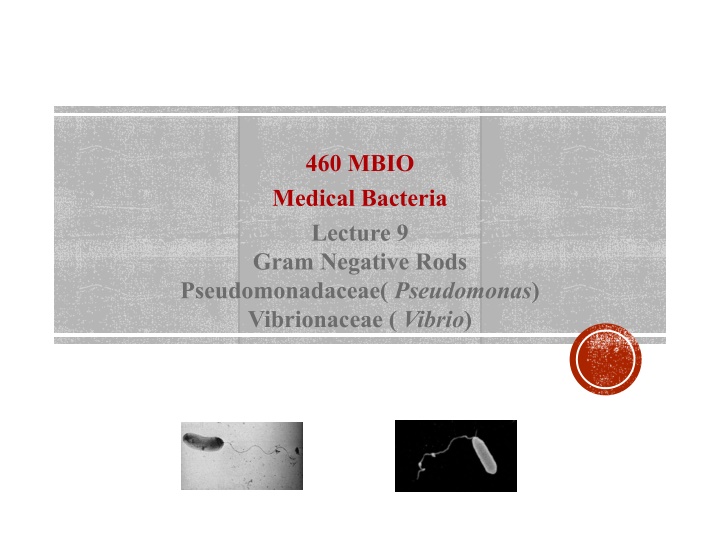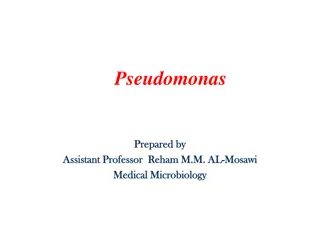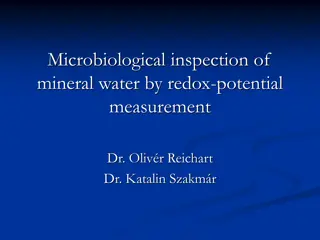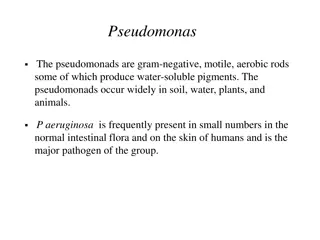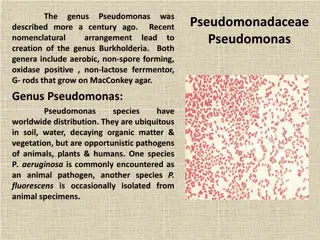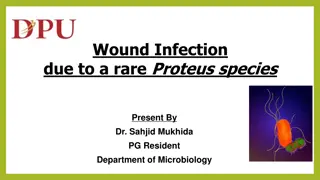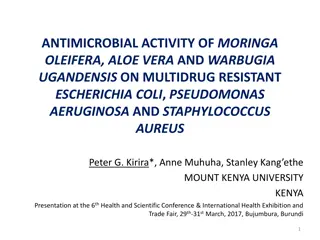Medical Importance of Pseudomonas aeruginosa in Healthcare
Pseudomonas aeruginosa is a significant Gram-negative bacterium found in various environments, including hospitals, water, soil, and sewage. It is a nosocomial pathogen and opportunistic pathogen with simple growth requirements. This bacterium is known for causing a range of infections in patients with compromised immune systems, producing distinct characteristics like soluble fluorescent pigments. Learn about its virulence factors, identification methods, and the infections it can lead to.
Download Presentation

Please find below an Image/Link to download the presentation.
The content on the website is provided AS IS for your information and personal use only. It may not be sold, licensed, or shared on other websites without obtaining consent from the author.If you encounter any issues during the download, it is possible that the publisher has removed the file from their server.
You are allowed to download the files provided on this website for personal or commercial use, subject to the condition that they are used lawfully. All files are the property of their respective owners.
The content on the website is provided AS IS for your information and personal use only. It may not be sold, licensed, or shared on other websites without obtaining consent from the author.
E N D
Presentation Transcript
460 MBIO Medical Bacteria Lecture 9 Gram Negative Rods Pseudomonadaceae) Pseudomonas( Vibrionaceae ) Vibrio(
Pseudomonadaceae )Pseudomonas( Manal M. Alkhulaifi General Characteristics Part of normal flora in human and animal intestine. Found in water, soil, sewage, vegetable, moist environment in hospitals. Pseudomonas Gram-negative rods Motile Aerobic ( respiratory metabolism , never fermentative) Versatile Catalase + Oxidase + Found in water, soil, sewage, vegetable, human and animal intestine and skin. Medical importance species: - - - - - - Pseudomonas aeruginosa Morphology Gram negative bacilli (seen under microscope among pus cell) Medium size Straight bacilli no curve Singly arranged Non-sporulated Non capsulated Highly motile Medical importance species: P. aeruginosa 1 P. aeruginosa - Part of normal flora in human and animal intestine, water, soil and moist environment in hospitals. Nosocomial pathogen- Opportunistic pathogens very simple growth requirement. It is often observed "growing in distilled water", evidence of minimal nutritional needs). Its optimum temperature for growth is 37 C, and it is able to grow at temperatures as high as 42C. Invasive and toxigenic infections in patients with abnormal host defenses Produce soluble fluorescent pyocyanin pigment, refers to "blue pus", which is a characteristic of suppurative infections caused by P. aeruginosa. Causes UTI (introduced by catheter)- Wound infection of burn sites, Septicemia, Otitis externa (Malignant external ear infection in poorly treated diabetic patients) Pneumonia- Eye infection (injury or surgery)- Endocarditis- bacteremia- meningitis- brain abscesses . Identification is based on colony morphology, oxidase-positive, growth at 42C- Non lactose fermintor - Bluish-green pigmented large colonies with fruity odor on culture media. It is resistant to high concentrations of salts and dyes, weak antiseptics, and many antibiotics - - - - - - - - P. aeruginosa Virulence Factors 1- Pilli (Adhere to epithelial cells) 2- Exopolysaccharide capsule (protected from opsonization by antibodies, complement & phagocytosis) 3- Biofilm (Biofilm mucoid strains of Pseudomonas are also less susceptible to antibiotics). 4- Motility: spread through tissues 5- Fluorescent pigment pyocyanin (impairs normal function of human nasal cilia, disrupts respiratory epithelium). 6- Enzymes: Two extracellular proteases associated with invasive stage: elastase & alkaline protease 2
Culture character Strict aerobic Grow on simple media. Its optimum temperature for growth is 37 C, and it is able to grow at temperatures as high as 42C. Showing flat colony & exopigment (pyocyanin which is bluish green & fluorescein which is yellowish green but present of two together give green colors) Has characteristic odor (ripen grapes or apple) has the ability to grow with minimal nutrients, e.g. in water and in the presence of some disinfectants; these properties are the key to its role as a hospital pathogen. Catalase + Oxidase + Found in water, soil, sewage, vegetable, human and animal intestine and skin. Manal M. Alkhulaifi Pseudomonas - - - - - - Gram-negative rods Motile Aerobic ( respiratory metabolism , never fermentative) Versatile Biochemical test Oxidase positive Medical importance species: P. aeruginosa Catalase positive Idol ve P. aeruginosa Gelatin liquefaction +ve Part of normal flora in human and animal intestine, water, soil and moist environment in hospitals. Nosocomial pathogen- Opportunistic pathogens very simple growth requirement. It is often observed "growing in distilled water", evidence of minimal nutritional needs). Its optimum temperature for growth is 37 C, and it is able to grow at temperatures as high as 42C. Invasive and toxigenic infections in patients with abnormal host defenses Produce soluble fluorescent pyocyanin pigment, refers to "blue pus", which is a characteristic of suppurative infections caused by P. aeruginosa. Causes UTI (introduced by catheter)- Wound infection of burn sites, Septicemia, Otitis externa (Malignant external ear infection in poorly treated diabetic patients) Pneumonia- Eye infection (injury or surgery)- Endocarditis- bacteremia- meningitis- brain abscesses . Identification is based on colony morphology, oxidase-positive, growth at 42C- Non lactose fermintor - Bluish-green pigmented large colonies with fruity odor on culture media. It is resistant to high concentrations of salts and dyes, weak antiseptics, and many antibiotics - Serological test Has O Ag & H Ag (motile) 2 Pseudomonas aeruginosa colonies on agar - - - - - - - - P. aeruginosa Virulence Factors 1- Pilli (Adhere to epithelial cells) 2- Exopolysaccharide capsule (protected from opsonization by antibodies, complement & phagocytosis) 3- Biofilm (Biofilm mucoid strains of Pseudomonas are also less susceptible to antibiotics). 4- Motility: spread through tissues 5- Fluorescent pigment pyocyanin (impairs normal function of human nasal cilia, disrupts respiratory epithelium). 6- Enzymes: Two extracellular proteases associated with invasive stage: elastase & alkaline protease 2
P. aeruginosa Disease: Nosocomial pathogen, Opportunistic pathogens. Cause invasive and toxigenic infections in patients with abnormal host defenses. Pyogenic wound infection, UTI, respiratory infection , otitis media,, eye infection,, endocarditis, septicemia , bacteremia, meningitis, brain abscesses. Produce soluble fluorescent pyocyanin pigment, refers to "blue pus", which is a characteristic of suppurative infections caused by P. aeruginosa. It is resistant to high concentrations of salts and dyes, weak antiseptics, and many antibiotics. highly resistance to antibiotic. Laboratory diagnosis: Identification is based on: colony morphology (Bluish-green pigmented large colonies with fruity odor on culture media) oxidase-positive growth at 42C non-lactose fermenter 3
Virulence Factors 1- Pilli (Adhere to epithelial cells) 2- Exopolysaccharide capsule (protect from antibodies and phagocytosis) 3- Biofilm 4- Motility:spread through tissues 5- Fluorescent pigment pyocyanin (impairs normal function of human nasal cilia, disrupts respiratory epithelium). 6- Enzymes: Two extracellular proteases associated with invasive stage: Elastase )digests protein( Alkaline protease )lyses fibrin(. 7- Toxins: Haemolysins (beta haemolysis) Phospholipase & lecithinase (destroy lipid and lecithin) Exotoxin A (Cytotoxic by blocking protein synthesis- pore forming protein), same mechanism of action as the diphtheria toxin . Exoenzyme S: interfere with membrane permeability Lipd A (Endotoxin): tissue necrosis Enterotoxins: food poising 8- Iron acquiring systems 9- Antibiotics resistance due to outer membrane changes. 4
Vibrionaceae (Vibrio( General Characteristics Vibrios are one of the most common organisms in surface waters of the world. Morphology comma-shaped Actively motile Medical importance species: Vibrio cholerae V. cholerae and V. parahaemolyticus Culture character aerobic and facultatively anaerobic. Optimum pH growth range 8.5- 9.5 (sensitive to acidic pH) Biochemical test ferment carbohydrates. oxidase-positive. Vibrios are distinguished from enterics by being oxidase-positive and motile by polar flagella. Vibrios are distinguished from pseudomonads by being fermentative and oxidative in their metabolism. 5
Vibrio cholerae V. cholerae is noninvasive ( not reach the blood), only act locally, affecting the small intestine through secretion of an enterotoxin. Found in fresh water, sea food. most often in communities with poor sewage and water treatment. Causes Cholera (epidemic cholera) is a severe diarrheal disease Transmission to humans is by contaminated water or food. Large inoculum (108 ) is required to cause disease because the Virulence factor Cholera toxin (heat-labile enterotoxin) is the most important virulence factor, action on the mucosal epithelium, it is responsible for the characteristic diarrhea of cholera disease. Mode of action: Cholera toxin activates the adenylate cyclase enzyme in cells of the intestinal mucosa leading to increase the secretion of H2O, Na+, K+, Cl-, and HCO3- into the lumen of the small intestine. 6
Cholera Cholera is one of the most rapidly fatal illnesses . Human may become hypotensive within an hour of the onset of symptoms and may die within 2-3h if no treatment. Vomiting and abrupt watery diarrhea ( Rice water stools is characteristic) contain enormous numbers of vibrios, mucosa, epithelial cells, result in severe fluids loss and dehydration. Can lead to shock, coma and death. The loss of potassium ions may result in cardiac complications and circulatory failure. Untreated cholera results in high (50-60%) mortality. Treatment: Give solution containing: (Glucose + Bicarbonate + Potassium) for fluids and electrolytes replacement Tetracycline shortens the duration of diarrhea and reduce fluid loss. 7
